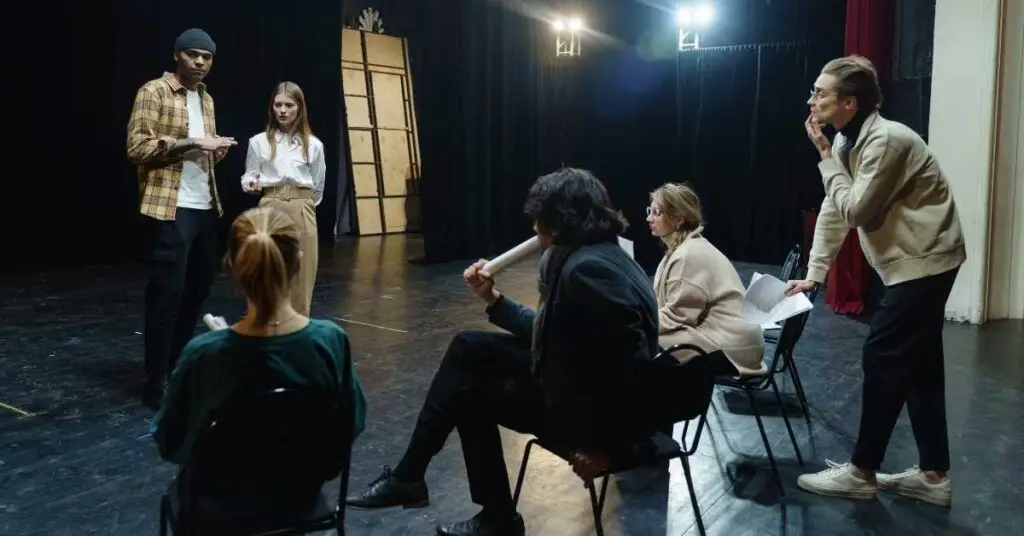Cold reading is when an actor is asked to perform a scene with very little preparation. This means that they will still be reading from the script. It is used almost exclusively in the audition process for all mediums including theatre, film, television and commercials.
Cold reading is often used in auditions because it allows casting directors to see how an actor handles the material cold, with no prior preparation. It also allows them to gauge an actor’s ability to take direction. Most actors find cold reading to be quite challenging, as it requires them to be fully present in the moment and to make quick, spontaneous decisions. However, with practice, it is possible to become quite proficient at cold reading. The best way to prepare for a cold reading audition is to familiarize yourself with the material beforehand, so that you are not completely blindsided when you are asked to perform it. Additionally, it is helpful to have some acting tools in your belt, such as being able to break down a script quickly, or having a strong imagination. Having strong Cold Reading skills can definitely give you an edge in the audition room.
How does cold reading work?
Cold reading is a technique that can be used to obtain information from someone without them realizing it. There are four main methods of cold reading: observation, collaboration, conversation, and redirection.
Observation is the simplest form of cold reading. By paying close attention to body language, facial expressions, and other nonverbal cues, it is possible to glean information about a person without them saying a word. For example, someone who is fidgeting or avoiding eye contact is likely to be nervous or uncomfortable, while someone with their arms crossed is likely to be defensive.
Collaboration involves working with another person to obtain information about the subject. This could involve asking leading questions or making statements that are designed to get a reaction. For example, a cold reader might say “You’re from out of town, aren’t you?” in order to elicit a response.
Conversation is similar to collaboration, but instead of working with another person, the cold reader uses the subject’s own words against them. For example, if the subject says “I’m not really sure what I want to do with my life,” the cold reader might say “It sounds like you’re feeling lost right now.”
Redirection is a technique that is often used when the cold reader has difficulty obtaining information from the subject. It involves changing the focus of the conversation or introducing new topics in order to sidetrack the subject. For example, if the subject refuses to answer questions about their personal life, the cold reader might ask about their work or hobbies instead.
Cold reading can be an effective way to obtain information from someone without them realizing it. By paying close attention to body language and facial expressions, and by asking leading questions or making statements that are designed to get a reaction, it is possible to glean information about a person without them saying a word.
Benefits of cold reading
Cold reading is the ability to quickly and effectively interpret a script or piece of writing without prior knowledge of the material. It is a vital skill for actors, who often have to audition for roles with little time to prepare. Cold reading can also be useful for other professionals who need to interpret complex written material on the fly, such as lawyers, teachers, and businesspeople.There are several benefits to cold reading.
First, it forces you to be present in the moment and attentive to the text. You can’t rely on pre-existing knowledge or assumptions when you’re cold reading, so you have to be completely focused on what you’re interpreting. This can help you to develop greater mastery of the material and to understand it more deeply.
In addition, cold reading can help you to become more flexible and adaptable in your interpretations. When you’re cold reading, you can’t get stuck in one way of thinking; you have to be willing to try different readings of the text until you find one that makes sense. This often leads to more creative and innovative interpretations.
Finally, cold reading is good practice for thinking on your feet and responding quickly to new information. This is a valuable skill in any profession where you may have to make quick decisions or come up with new ideas on the spot.
Challenges of cold reading
One of the challenges of cold reading is that it can be difficult to connect with the material. When you are given a scene or monologue to read cold, you often have very little time to prepare. This can make it difficult to connect with the character and the situation, which can lead to a wooden or flat reading.
Additionally, cold reading can be challenging because it requires you to be extremely present in the moment. You can’t rely on any previous preparation or understanding of the material, which means that you have to be 100% focused in order to deliver a strong performance. However, mastering the art of cold reading can be tremendously rewarding. It is a valuable skill for actors to have, as it allows them to audition for roles without any prior preparation.
Additionally, cold reading can help actors to become more present and spontaneous in their work.
Tips for improving your cold reading skills
A cold read is when an actor is given a piece of text and asked to perform it without any prior rehearsal. It can be a daunting task, but there are some things you can do to improve your cold reading skills.
First, request collaboration from the person you’re reading with. This will help create a more comfortable environment and allow you to better connect with your scene partner.
Second, pay attention to the details in the text. What are the characters’ names, ages, occupations? What is the setting of the piece? The more specific information you can glean, the easier it will be to connect with the material.
Third, keep your guesses broad. If you’re unsure about something, don’t focus on one particular interpretation; instead, try a few different options and see what feels most natural.
Finally, if you find yourself going down a wrong path, direct the subject’s attention away from your mistake and back to the text. By following these tips, you’ll be able to approach cold reads with confidence and ease.
Examples of cold readings from famous movies and TV shows
A cold reading is when an actor or actress is given a script or lines to memorize without prior knowledge of the story. Cold readings are often used in auditions or during filming when there is not enough time to prepare. While they can be challenging, cold readings can also be a great way to showcase your acting chops. Here are a few examples of cold readings from famous movies and TV shows:
1. “The Breakfast Club” – When the five main characters are first introduced, they are each given a one-line description by the school principal. The actors then had to improvise their own dialogue based on these brief profiles.
2. “Seinfeld” – In the episode “The Chinese Restaurant”, the cast had to improvise most of their dialogue while waiting for a table at a crowded restaurant.
3. “Lord of the Rings: The Fellowship of the Ring” – When Bilbo Baggins (Ian Holm) reads the riddle to Gollum (Andy Serkis), both actors were given only their lines and had to ad-lib the rest of the conversation.
4. “Breaking Bad” – In the episode “Cat’s in the Bag”, Aaron Paul and Bryan Cranston improvise an entire scene where they discuss what to do with a dead body.
5. “The Office” -In the episode “Dwight’s Speech”, Steve Carell’s character Dwight gives a speech at Michael’s farewell party without knowing what he will say ahead of time. Carell improvised the entire speech, which proved to be one of the most memorable moments from the series.
Cold reading can be a great way to show off your acting skills. By being present in the moment and staying true to the material, you can deliver a powerful performance that will impress your audience.
How to use cold readings in your own acting performances?
A cold reading is when an actor is given a script or scene to read aloud with another actor, without any prior rehearsal. This can be daunting, but there are ways to make it work to your advantage.
First, take a moment to familiarize yourself with the material. What is the setting? What is the tone? What is your character’s motivation? Once you have a sense of the context, you can begin to flesh out your character. Think about how they would speak and move; what would their body language say? As you read through the scene, let yourself be present in the moment and react naturally to what your scene partner is saying and doing. If you can stay in the moment and respond truthfully to the situation, your performance will be all the richer for it.
Conclusion
Cold reading can be a great way to showcase your acting skills. By being present in the moment and staying true to the material, you can deliver a powerful performance that will impress your audience. With a little practice, you can use cold readings to your advantage and create memorable moments in your own acting career.











